Today the correct approach to data management determines if you maintain the competitive advantage. Many business leaders support that message. According to Deloitte, nearly 70% of global executives agree that digital transformation is the most vital investment for locking in organizational success. Of those respondents, 90% highlight data and analytics as the top priority in their efforts. However, despite this focus, only half of the surveyed companies have managed to cultivate a data-centric culture.
Many organizations continue to face challenges in effectively utilizing their data for extracting strategic insights. Yet, the correct approach to data can shape the whole course of all the business processes. To set your data initiatives on the right track, you need to have the data management framework. In this article, we examine why it is important and what are the best practices for creating one.
Data Management Framework Definition
To understand how the framework helps to organize all your data-related activities, let’s define its role and purpose.
What Is Data Management Framework?
A data management framework is a structured approach, a vision that defines the processes, policies, technologies, and roles required to manage an organization’s data assets effectively. It provides a structure for how data is created, stored, maintained, and utilized throughout its lifecycle, ensuring data is accurate, secure, accessible, and aligned with business objectives.
A data management framework helps organizations to maximize the value of their data. It is usually done by achieving consistency and quality, compliance with regulatory requirements, facilitating the reliable use of data, and minimizing risks related to data breaches, loss, or mismanagement.
The framework should not be confused with the data management roadmap, which is a strategic document containing the steps and milestones necessary to achieve the objectives defined by the framework. Data management strategy, in turn, is formed based on the roadmap.

Dmytro Timofiev
Delivery Manager at SPD Technology
“I’d like to emphasize that a data management framework is a guide for your data efforts on the road toward a data-driven organization. Without a clear framework, companies can’t build a sustainable and scalable data infrastructure.”
Benefits of Implementing Data Management Framework
According to McKinsey, incomplete, inconsistent, and inaccurate data is one of the major challenges for 50% of companies representatives surveyed. This is where the framework becomes especially useful as it provides companies with a defined vision for handling their data assets. This, in turn, positively impacts both day-to-day operations and long-term business ventures.
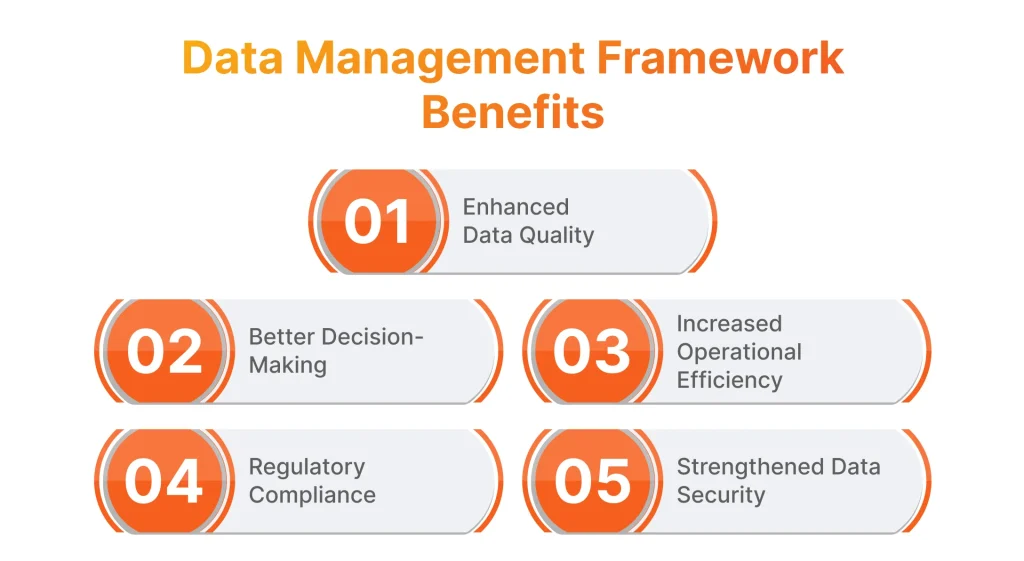
Consider the following advantages of implementing the framework to understand its value:
- Enhanced Data Quality: The framework ensures that data avoids errors and discrepancies. With the focus on quality, it ensures that the clean data contributes to the effectiveness of analytics and reporting.
- Better Decision-Making: As long as the framework provides the team with structured access to high-quality data, all stakeholders across the company can make strategic decisions on the basis of reliable insights instead of assumptions.
- Increased Operational Efficiency: Businesses that choose to follow the framework make sure that it helps streamline data processes and reduce duplicates. In such a way, the personnel usually experience a productivity boost.
- Regulatory Compliance: One of the framework’s focuses is data governance and security protocols. Thanks to that, organizations meet legal and industry-specific regulations concerning data management and avoid penalties.
- Strengthened Data Security: The framework enforces stringent security measures to make sure data is securely stored, managed, and accessed only by authorized personnel.
Key Components of Data Management Framework
The data management framework introduces several initiatives. Each plays a crucial role providing all the necessary means for establishing a data-driven enterprise. See the breakdown of data management components below.
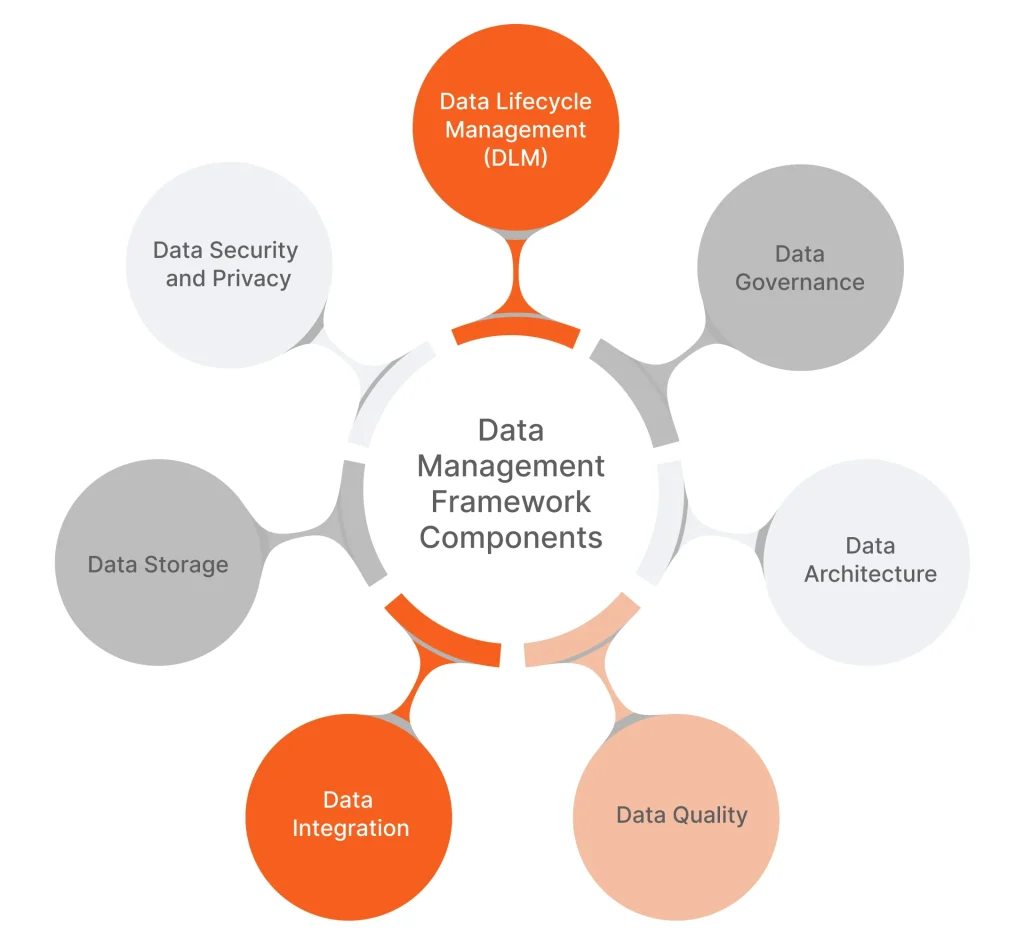
Data Governance
Data governance is the set of policies, procedures, standards, and roles that guide how data is managed across the organization. It ensures data is accurate, secure, and used effectively to meet business objectives. The data governance framework consists of:
- Policies and Standards
- Data Stewardship
- Governance Committees
- Compliance Management Processes
- Metrics and Monitoring Tools.
The primary goal of data governance structure is to establish accountability and ensure the data is reliable, secure, and accessible. Data governance initiatives minimize risks of data misuse and promote an informed decision-making process.
Data Architecture
Data architecture is the design of how an organization structure, store, and access its data. It outlines how data is collected, stored, integrated, and utilized, providing a structured approach for managing data flow and ensuring that data aligns with business strategies.
The components of data architecture are:
- Data Models
- Data Flow Diagrams
- Integration Platforms
- Metadata Repositories
- Standards and Protocols
Data architecture ensures that information flows easily across departments and applications by addressing such aspects as consistency and scalability. One of the critical solutions within the frame of data architecture is building data pipelines for keeping data organized and, thus, boosting operational efficiency. For example, we leveraged our data expertise and helped a US-based business research company to data loading and processing pipeline as the main components of the AI-powered tool for automating the data collection process. Our efforts resulted in 100% atomated of media image metrics calculation.
Data Quality
Data quality refers to the measures that make data clean, accurate, complete, consistent, and reliable. Accenture reports that data scientists spend over 80% of their time preparing and cleaning data to make it fit for use for analytical purposes – this is how refined data is important for organizations. Therefore, it is a vital factor to include in the framework.
Data quality involves the following tools and processes:
- Data Profiling Tools
- Validation Rules
- Data Cleansing Processes
- Quality Metrics
- Continuous Monitoring Systems.
While poor data quality can lead to misguided strategies, financial losses, and reputational damage, high quality data reduces errors, increases efficiency, and builds trust in the data. We adopted a qualitative approach to data, when working on our client’s peer-to-peer lending platform. We implemented data quality standards that led to a 40% reduction in data errors.
Data Integration
When it comes to data integration, it means that the framework defines the process of combining data from different sources to provide a single, unified view. In such a way, it becomes possible to ensure that data is consistent and accessible across the company’s systems and applications.
Data integration focuses on the following:
- ETL Processes
- Data Warehouses and Lakes
- Middleware Solutions
- APIs and Web Services
- Data Synchronization Tools.
Combining data from disparate sources enables coherent analysis and reporting. The importance of data integration lies in seamless data flows across different systems, applications, and databases. This entails breaking down silos and promoting a holistic understanding of information.
Data Storage
The increase in data creation is the reason why global revenue in the data center market’s storage is projected to grow by over 70% from 2024 to 2029. That statistics also means that companies will spend a lot on storing data. However, with an effective approach to data storage, the cost may be reduced. The framework addresses this aspect that encompasses the methods and technologies (hardware and software) used to store and retrieve data.
Critical components of data storage are:
- Database Systems
- Cloud Storage Services
- Storage Area Networks
- Archival Systems
- Backup and Recovery Tools.
The enterprise data management framework with a proper storage approach ensures that data is preserved securely and is readily available upon request. This ensures business continuity and optimizes performance because the company uses the right storage solutions for different types of data.
Data Security and Privacy
During 2023, businesses and individuals experienced 72% more data breaches than in 2021 and 2022. For this reason, data security is another crucial component of the framework that explains how to safeguard sensitive data from unauthorized access, breaches, and misuse. Here, compliance importance is also highlighted, indicating the significance of data privacy regulations such as GDPR, HIPAA, and CCPA.
The essential factors addressed within the frame of data security are:
- Encryption Methods
- Access Controls
- Firewalls and Intrusion Detection Systems
- Privacy Policies
- Regulatory Compliance Measures.
The importance of data security lies in maintaining customer trust and protecting the organization’s reputation. When the organization’s data assets are secure, companies safeguard their business and customers from breaches and legal penalties.
Data Lifecycle Management (DLM)
DLM is a policy-driven approach that allows keeping focus on data during its full lifecycle, from creation to eventual disposal. This approach guarantees efficient data management at every stage of its lifespan, maximizing compliance, retention, and storage.
DLM prioritizes the following areas:
- Lifecycle Policies
- Data Classification Schemes
- Retention Schedules
- Archiving Solutions
- Disposal Procedures.
With DLM, companies can ensure efficient use of storage resources, reduce costs, and maintain adherence to laws and regulations. Thanks to including this aspect in the framework, companies get benchmarks in mitigating risks associated with outdated or unnecessary data.
Choose Right Data Management Framework for Your Business
You do not have to invent the framework from scratch: there are proven ones that address specific project areas and in some cases it might be a better option than a custom one. However, you need to focus on selecting the appropriate framework to make sure you accommodate your most pressing needs. This guarantees that your project will go according to test methodologies, best practices, and guidelines. Let’s review some of the examples.
Adapt and Adopt Established Frameworks
We offer you to take the following frameworks to your attention.
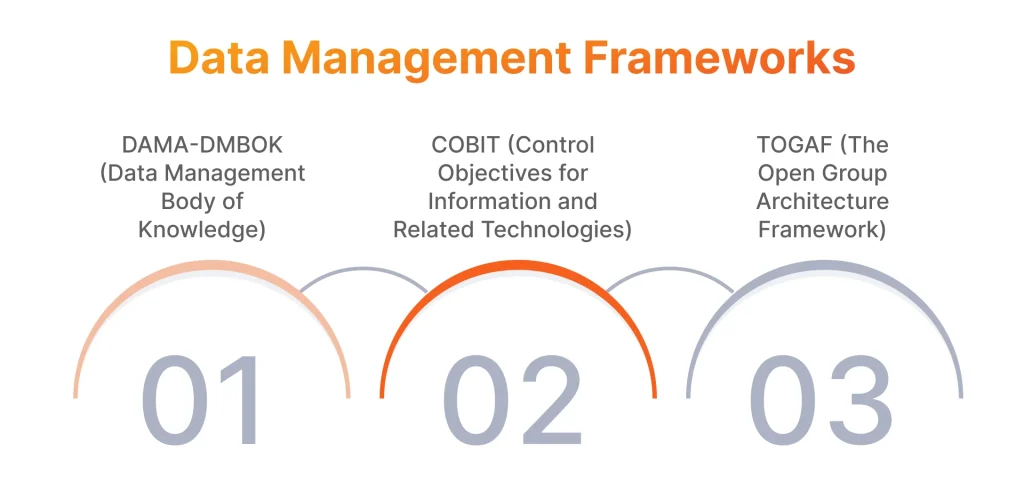
DAMA-DMBOK (Data Management Body of Knowledge)
The DAMA-DMBOK is an authoritative framework that defines the key disciplines essential for competent data management. It covers several foundational areas including data governance, data architecture, data quality, and data storage. Thus, this framework offers an all-in-one approach to handling critical business information.
DAMA-DMBOK encourages standardized processes and a shared knowledge across teams. Businesses looking to improve data quality management and build strong data governance may find this methodology especially helpful.
COBIT (Control Objectives for Information and Related Technologies)
COBIT is a data control framework that encompasses a broad range of IT processes, it emphasizes specific components relevant to data management, such as information security, data integrity, and compliance.
Adopting COBIT means firms can guarantee regulatory compliance, establish efficient risk management procedures, and match their IT strategy with their long-term business plans. Organizations that need strict control over their data-related procedures and information systems should use this approach.
TOGAF (The Open Group Architecture Framework)
TOGAF outlines a structured approach for designing, planning, implementing, and governing an enterprise information architecture. It offers tools and methodologies for developing data architectures, facilitating effective data integration, and promoting scalability.
In order to ensure that data management initiatives complement broader corporate objectives, it stresses the connection of IT strategy with business goals. Organizations that thrive for achieving greater flexibility in data management practices, enhanced interoperability between systems, and support for long-term strategic planning need to pay attention to this framework.

Dmytro Timofiev
Delivery Manager at SPD Technology
“You can also try and combine elements from these frameworks. Each of them offers distinct advantages, and incorporating a little bit of each, you can achieve a customized solution that maximizes the effectiveness of your data management.”
Designing a Custom Framework
While recognized frameworks like DAMA-DMBOK, COBIT, and TOGAF allow you to benefit from proven tactics, stakeholders may still see the need for a tailored approach to address specific issues or find competitive advantage. So, let’s see some recommendations on creating a custom framework.
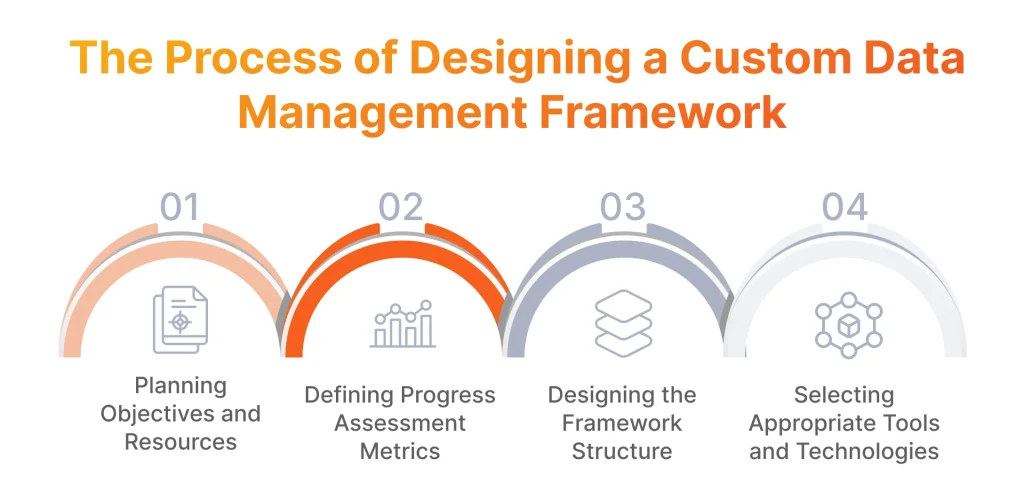
Planning Objectives and Resources
Begin by clearly defining the goals you aim to achieve with your framework. You might aim for improving data quality, ensuring regulatory compliance, or enhancing data accessibility. The data management framework can be focused on one of these objectives (suitable for smaller businesses) or target several at once (suitable for enterprises).
Whatever goal you choose, you need to pinpoint the most important objective and evaluate if your current resources (personnel, technology, budget, and data assets) can accommodate the enterprise data strategy you follow. If not, identify existing strengths and gaps, and make sure you can fill them during the framework implementation.
Defining Progress Assessment Metrics
Equally important is assessing your progress. For that, you can establish KPIs as they provide insights into the effectiveness of their data management initiatives. They span various components of the framework, such as data governance, data quality, data storage, etc. Some of the KPIs you might need are data accuracy rate, data completeness, regulatory compliance rate, data retrieval speed, and/or user satisfaction score. However, you can focus on those more relevant to your project.
Designing the Framework Structure
With your objectives defined, focus on building the structure of your framework. For that, identify the core components necessary for data management, such as data governance, architecture, quality management, metadata management, and security. Then, develop standardized processes and policies for data collection, storage, processing, and dissemination. In this manner, you ensure consistency and reliability across all data management activities.
Selecting Appropriate Tools and Technologies
The next step is equipping your framework with the selection of tools and technologies. We recommend beginning by identifying the specific functionalities and capabilities required to support your framework. Here, you need to pay attention to data integration, analytics, reporting, visualization, and security. Based on your need, select technologies compatible with your current capabilities.
Data Management Framework Implementation
Now let’s talk about the phases required for a successful framework implementation. Their sequential execution ensures that data promotes informed decision-making.
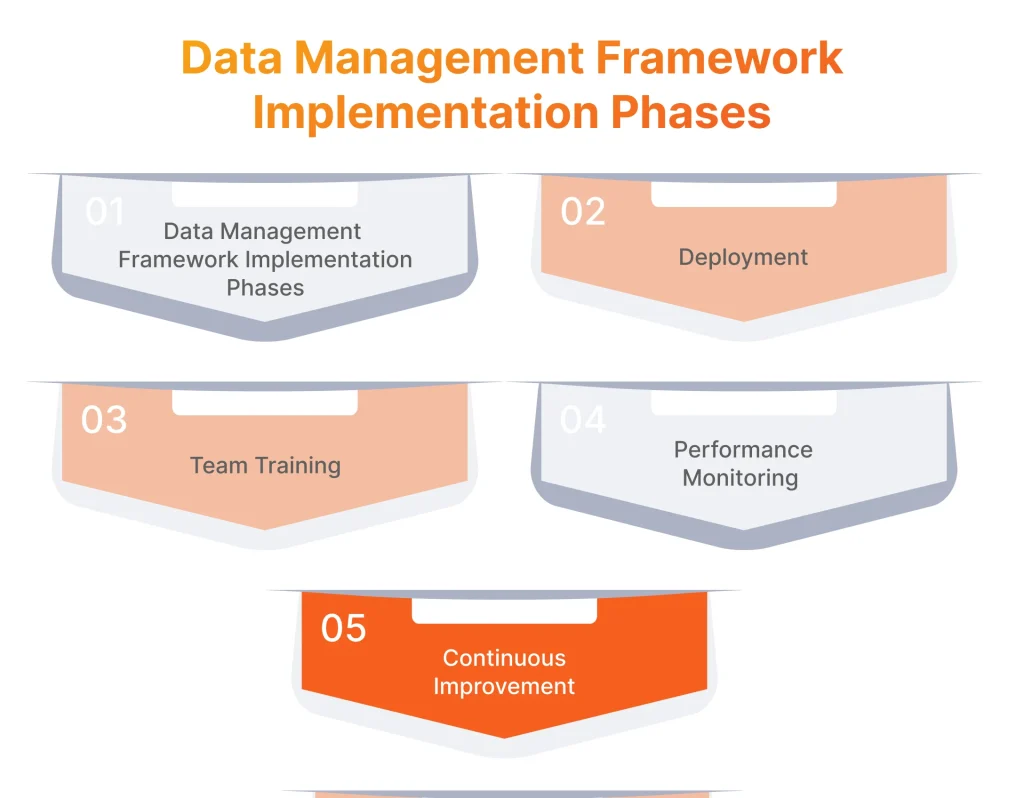
Deployment
First comes the deployment phase. The process starts with assessing the existing data infrastructure and identifying any issues connected to the framework components. After the evaluation, the next priority is establishing governance structures. This means elaborating responsibilities for data stewards and owners, as well as setting up procedures that help control how data is accessed, managed, and secured.
Following the governance setup, the technical implementation takes place. It focuses on integrating tools and systems that enable data quality management, security protocols, and process automation. Plus, if you are willing to streamline the data processes and reduce error, automation solutions will be helpful during this stage.
Team Training
Your company cannot move to new data practices without a proper training and education. Let your team adopt new practices, approaches, technologies, and tools. This may involve creating training programs, conducting workshops, webinars, and hands-on sessions. Also, consider tailoring training sessions to address the specific needs of different roles within your organization.
It is also crucial that your team revisit some documentation or learning materials. Therefore, your company needs to take care of the creation of a knowledge repository with resources, tutorials, and FAQs.
Performance Monitoring
To measure the effectiveness of the key activities in the frame of your data management framework and, thus, achieve competitive advantage, assess the progress according to the established key performance indicators (KPIs). Focus KPIs that include metrics related to data quality, data accessibility, compliance rates, user satisfaction, or any that can help to understand the progress of the implementation.
Moreover, you can conduct regular audits and assessments to guarantee that the framework is functioning as intended. You can use automated tools and manual reviews to evaluate data governance practices, adherence to policies, and the overall health of your data ecosystem.
Continuous Improvement
As technologies advance at a rapid pace, business requirements evolve, and company grows, new challenges also emerge. The framework should be flexible enough to adapt and accommodate the growing needs. Those needs may be scaling data infrastructure, integrating new technologies, ensuring compliance with updated regulations, and addressing increased data volume, security threats, and advanced analytics requirements.
In addition to such a flexible adjustment approach, prioritize changes that address critical issues and document those changes to avoid misunderstandings across the departments.
Data Management Framework Implementation Best Practices
To achieve a proper execution of the framework, we strongly advise applying industry best practices concerning standardization, automation, and stakeholder engagement. Below, we provide an overview of how we use them to ensure best results for our clients.
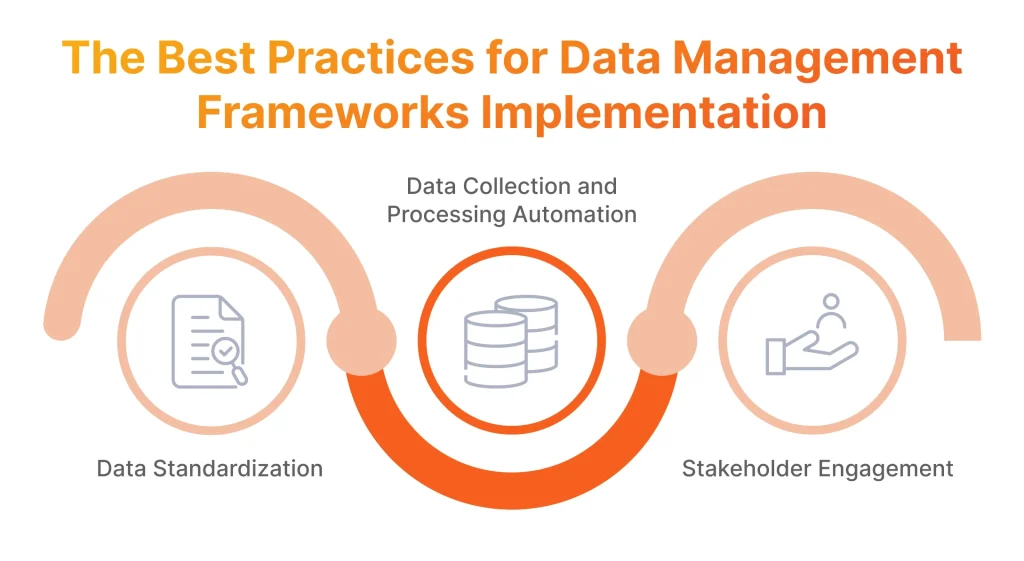
Standardization
Our data scientists focus on standardization to ensure uniformity in data handling, which significantly improves data quality and reduces discrepancies. Thanks to following this practice, we adopt unified data standards, such as standardized formats and definitions, it facilitates seamless integration across different systems and departments. For example, we worked on harmonized data for categorization, when developing functionalities for a US-based online store. After we removed data discrepancies, our team achieved an impressive 90% accuracy in categorization allowing the store to attract 1.5 times more customers.
Automation
If your project needs to handle repetitive tasks like data entry, cleansing, and validation with the utmost efficiency, we usually set up automated processes. Automation saves around 40% of the time spent on data collection and processing. As we establish automated workflow, we not only speed up your processes but also minimize errors and improve productivity as it promotes the focus on strategic initiatives.
Consequently, when our team designs streamlined workflows through automation, we ensure smooth data flow between systems, maintain consistency, and enable timely updates. While developing the ML-powered solution for paperwork and invoice processing for our client, we were required to automate data collection and processing. As a result of our efforts, the system was completely automated and processing time and errors were significantly reduced.
Stakeholder Engagement
We also believe that involving stakeholders for refining the framework is equally important. This is why we always engage professionals across all departments to contribute to the framework from the very first stages. In such a way, our team guarantees gathering of diverse insights and addressing the vital needs of the organization. This collaborative relationship between IT, data specialists, and business units, enables us to promote seamless integration of the framework and quick resolution of any challenges that arise.
Consider Professional Data Management Consulting Services
One of the advantages of strategic technology consulting is that professionals focus on core business values, look for innovation opportunities, and are ready to execute sharp expertise blended with proven skills. When it comes to implementing a framework, partnering with our team can provide an edge in terms of strategy, execution, and results. Check below what you can get when collaborating with us.
Why Choose SDP Technology for Data Management Consulting?
Partnering with our team means working with a team that not only designs the strategy but also has the expertise to implement it successfully. The collaboration with us is supported by:
- Best Practices and Proven Methodologies: We employ time-tested best practices and methodologies refined through extensive industry experience. Thus, we ensure your data management processes are both efficient and reliable.
- Comprehensive Expertise and Experience: At SDP Technology, we go beyond consulting. We also specialize in data engineering, and deep expertise in actual implementation means that our recommendations are grounded in real-world experience, ensuring practical results.
- Advanced Technology and Tools: From AI-driven analytics to cloud-based or microservices platforms, we utilize advanced tools to help you stay ahead of the curve and enhance your data management capabilities.
- Focus on Business Value and ROI: Every data management strategy our data scientists design is aimed at maximizing your ROI, improving operational efficiency, and supporting data-driven decision-making processes that lead to growth.
Our Success Stories
Supported by our thorough approach to building a data management framework, we bring our strategic vision to life, delivering measurable results for businesses.
HaulHub’s Data-Driven Growth with Scalable Data Solutions
One of our notable cases comes from our collaboration with HaulHub, a transportation construction company. We were tasked with the development of an all-in-one platform for the construction ecosystem. The project required building complex features such as digital ticketing, traffic analysis, and data visualization for agencies, contractors, and suppliers. Additionally, the platform also needed real-time project tracking and an AI-driven chatbot. All of those tasks required a diligent approach to data management.
Our team focused efforts on overhauling the data infrastructure to handle large datasets, enabling real-time processing and visualization. We paid particular attention to redesigning the data architecture to efficiently manage large-scale datasets, enabling real-time data processing and visualization capabilities. This included creating scalable data pipelines, establishing a comprehensive Data Lake, and seamlessly integrating external systems to optimize data flow and accessibility.
Upon the implementation of the planned scope of work, the client’s platform was equipped with such data-driven functionality as digital inspection, live construction activity view, activation and deactivation of digital work zones, worker presence analysis, automated traveler alerts, and more. These improvements have streamlined operations, boosted efficiency, and supported over 500 contractors across the U.S.
Enabling Morning Star to Scale Mission-Critical Business Data
Another data management example where we implemented the framework was for Morning Star, a billion-dollar U.S. asset management company. The client was facing significant challenges with their data collection system, which was limiting their ability to scale and effectively manage vast amounts of financial data.
By applying our meticulously-designed data management framework, our team completely overhauled and expanded their data collection application. We improved data reliability, processing speed, and scalability, enabling them to handle more data efficiently. Our team also redesigned data architecture, automated manual collection of financial report information, and set up efficient data integration with an external company’s partner.
Our approach allowed the company to rule out 90% of the possible data losses and optimize operations, which translated into higher system performance. As a result of our efforts, the client unlocked a new business line and started providing IPO data on behalf of one of the world’s premier providers of investment data.
Conclusion
A data management framework is a systematic strategy that sets data rules essential for the effective management of an organization’s data assets. Having it in place means enhanced data quality, better decision-making, increased operational efficiency, compliance with regulations, and strengthened security. The critical components of a framework include data governance, architecture, quality, integration, storage, security, and lifecycle management.
There are proven approaches to developing a framework such as DAMA-DMBOK, COBIT, and TOGAF. However, you can also create a custom framework to align it with your unique vision. When the framework is ready, you can proceed with its implementation, which involves deployment, monitoring, and ongoing adjustments.
Such techniques as standardization, automation, ongoing staff training, and stakeholder engagement contribute to the overall success of the implementation. In case you still don’t feel sure about how to craft a coherent framework for your organization, you can contact us. We will carefully analyze your requirements and tailor a custom vision for your company.
FAQ
What Is a Data Management Framework?
A data management framework is a structured approach that defines the processes, policies, technologies, and roles required to manage an organization’s data assets effectively. It serves as a foundation for making data clean, accurate, consistent, and reliable. Moreover, the framework ensures that your data activities contribute to your overall organizational goals.
Who Creates and Maintains the Data Management Framework?
Typically, a cross-functional team works on the data management framework. This team includes data managers, IT professionals, and business stakeholders. Data governance committees or data stewards oversee its development and ensure it complies with regulatory requirements.
What Is the Purpose of the Data Management Framework?
The purpose of a data management framework is to provide a consistent approach to managing data assets. It ensures data quality, security, and accessibility, supports regulatory compliance, and enables data-driven decision-making.

